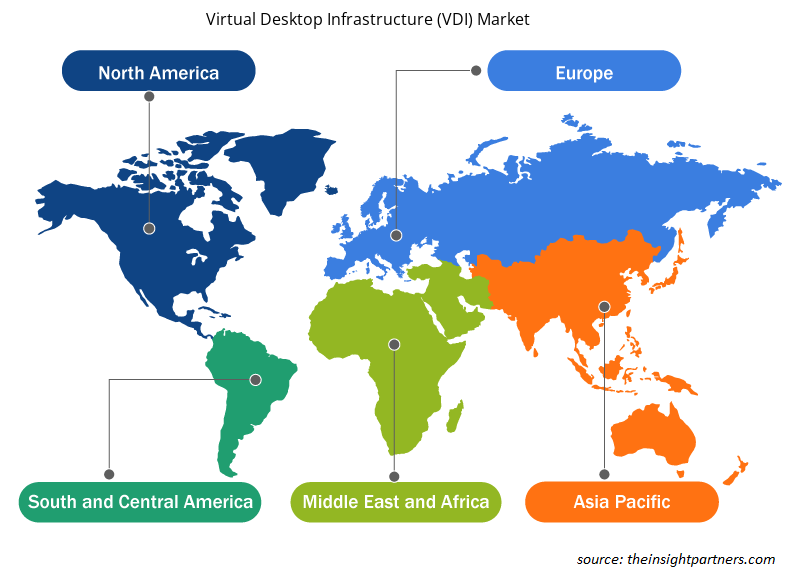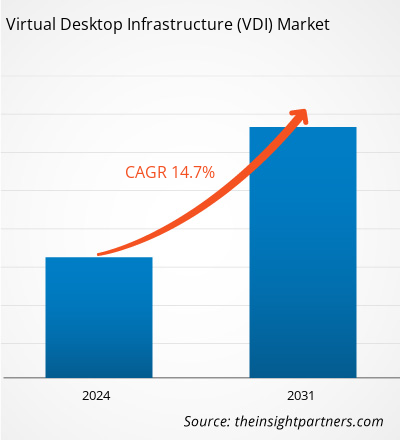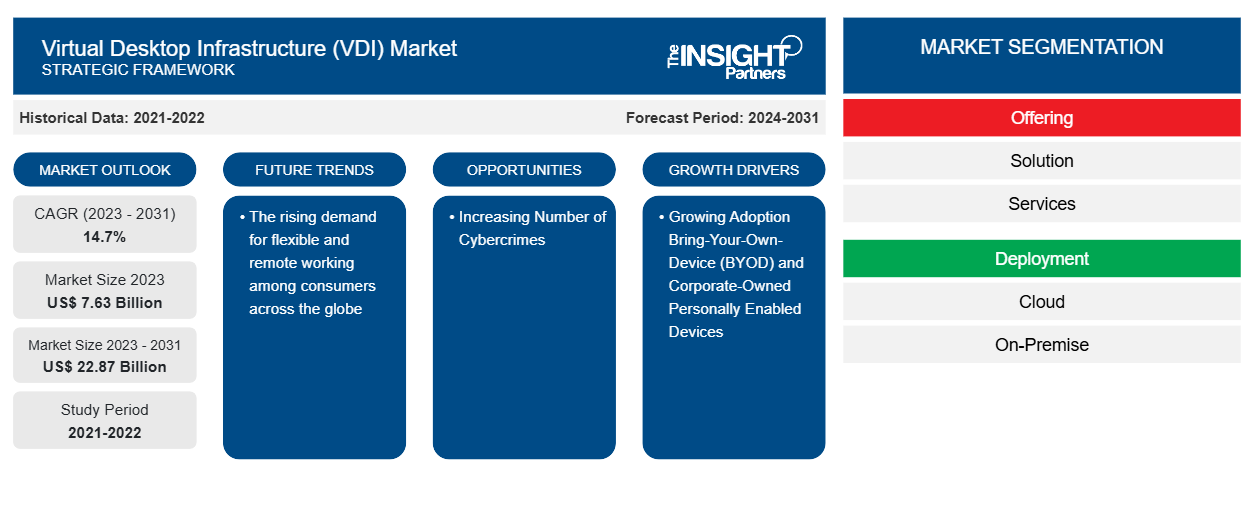Der Markt für virtuelle Desktop-Infrastrukturen (VDI) soll von 7,63 Milliarden US-Dollar im Jahr 2023 auf 22,87 Milliarden US-Dollar im Jahr 2031 anwachsen. Der Markt soll in den Jahren 2023–2031 eine durchschnittliche jährliche Wachstumsrate (CAGR) von 14,7 % verzeichnen. Die steigende Nachfrage nach flexiblem und Remote-Arbeiten bei Verbrauchern auf der ganzen Welt dürfte ein wichtiger Markttrend für virtuelle Desktop-Infrastrukturen (VDI) bleiben.
Marktanalyse für virtuelle Desktop-Infrastrukturen (VDI)
Der Markt für virtuelle Desktop-Infrastrukturen (VDI) wächst rasant, da immer mehr BYOD-Geräte und unternehmenseigene, persönlich aktivierte Geräte verwendet werden und die Verbraucher zunehmend Sicherheitsbedenken haben. Der Markt wächst stetig, angetrieben von expandierenden KMUs und strengen staatlichen Vorschriften für Sicherheitsmaßnahmen. Darüber hinaus bieten die zunehmende Zahl von Cyberkriminalität und die Integration fortschrittlicher Technologien wie KI, Cloud Computing und IoT in virtuelle Desktop-Infrastrukturen lukrative Möglichkeiten für Marktwachstum.
Marktübersicht für virtuelle Desktop-Infrastrukturen (VDI)
Lösungen für virtuelle Desktop-Infrastrukturen (VDI) basieren häufig auf einer Client/Server-Architektur mit dem Betriebssystem und den Anwendungen des Unternehmens. Die VDI-Lösungen laufen auf einem Server in der Cloud oder einem Rechenzentrum. In dieser Architektur finden alle Interaktionen mit Benutzern auf einem lokalen Gerät nach Wahl des Benutzers statt. VDI ist auch eine wichtige Komponente digitaler Arbeitsplätze, da moderne virtuelle Desktop-Workloads auf Technologie für virtuelle Desktop-Infrastrukturen angewiesen sind, die auf virtuellen Maschinen entweder vor Ort oder in öffentlichen Cloud-Rechenzentren ausgeführt werden. Dies belebt den Markt und steigert die Nutzung virtueller Desktop-Infrastrukturen in Unternehmen, um die Arbeit der Mitarbeiter zu rationalisieren.
Passen Sie diesen Bericht Ihren Anforderungen an
Sie erhalten kostenlos individuelle Anpassungen an jedem Bericht, einschließlich Teilen dieses Berichts oder einer Analyse auf Länderebene, eines Excel-Datenpakets sowie tolle Angebote und Rabatte für Start-ups und Universitäten.
- Holen Sie sich die wichtigsten Markttrends aus diesem Bericht.Dieses KOSTENLOSE Beispiel umfasst eine Datenanalyse von Markttrends bis hin zu Schätzungen und Prognosen.
Markttreiber und Chancen für virtuelle Desktop-Infrastrukturen (VDI)
Wachsende Akzeptanz von Bring-Your-Own-Device (BYOD) und unternehmenseigenen, persönlich aktivierten Geräten treibt den Markt an
Der Ausbau der mobilen Belegschaft erhöht die Nachfrage nach virtuellen Desktop-Infrastrukturen zur Verbesserung der Produktivität von Unternehmen. Die virtuelle Desktop-Infrastruktur bietet Mitarbeitern den Vorteil, dass sie über ihre Smartphones, Laptops und Mobiltelefone auf ihre virtuellen Desktop-Bilder zugreifen können. Die zunehmende Verbreitung von BYOD und unternehmenseigenen, individuell aktivierten Geräten treibt die Nachfrage nach virtuellen Desktop-Infrastrukturen in der IT- und Telekommunikationsbranche an. Unternehmen stehen unter Druck, fortschrittliche virtuelle Technologien einzuführen, die auf die Konsumerisierung von IT, Mobilität und BYOD zurückzuführen sind. Dies erhöht ihren Fokus auf die Entwicklung fortschrittlicher virtueller Desktop-Infrastrukturen zur Verwaltung der IT-Konsumerisierung und der Kosten. Die Desktop-Virtualisierung wird jedoch aufgrund verbesserter Sicherheit, Compliance und Governance immer beliebter, was den Markt im Prognosezeitraum voraussichtlich ankurbeln wird.BYOD and corporate-owned individually enabled devices is propelling the demand for the virtual desktop infrastructure market in the IT and telecom industry. Businesses are working under pressure to adopt advanced consumerization of IT, mobility, and BYOD. This increases their focus on developing advanced virtual desktop infrastructure to manage IT consumerization and costs. However, desktop virtualization is becoming increasingly popular due to enhanced security, compliance, and governance, which is expected to fuel the market during the forecast period.
Zunehmende Zahl von Cyberkriminalität – eine Chance auf dem Markt für virtuelle Desktop-Infrastrukturen (VDI)Cybercrimes – An Opportunity in the Virtual Desktop Infrastructure (VDI) Market
Fortschritte in der Virtualisierungstechnologie haben die Nutzung virtueller Desktop-Infrastrukturen in Unternehmen angekurbelt, um Sicherheit und Compliance gegen Datenlecks und Cyberangriffe zu priorisieren. Die steigende Zahl von Cyberkriminalität weltweit schafft Chancen auf dem Markt. Laut dem Bericht „Digital Banking Fraud Trends in North America“ von BioCatch vom Dezember 2023 stiegen beispielsweise die Mobile-Banking-Raten im Jahr 2023 auf 73 %. Dies wiederum führte zu einem erheblichen Anstieg der über mobile Geräte ausgeführten Betrugsfälle, von 47 % im Jahr 2022 auf 61 % im Jahr 2023. Dies erhöht die Nutzung virtueller Desktop-Infrastrukturen bei Benutzern, um Risiken zu verringern und ihre Daten und Informationen vor Cyberangriffen zu schützen.
Marktbericht zur virtuellen Desktop-Infrastruktur (VDI) – Segmentierungsanalyse
Wichtige Segmente, die zur Ableitung der Marktanalyse für virtuelle Desktop-Infrastrukturen (VDI) beigetragen haben, sind Angebot, Bereitstellung, Unternehmensgröße und Endbenutzer.
- Basierend auf dem Angebot ist der Markt für virtuelle Desktop-Infrastrukturen (VDI) in Lösungen und Dienste unterteilt. Das Lösungssegment hatte im Jahr 2023 einen größeren Marktanteil.
- In Bezug auf die Bereitstellung wird der Markt in Cloud und On-Premise unterteilt. Das Cloud-Segment hatte im Jahr 2023 einen größeren Marktanteil.
- Auf der Grundlage der Unternehmensgröße ist der Markt für virtuelle Desktop-Infrastrukturen (VDI) in KMU und Großunternehmen unterteilt. Das KMU-Segment hatte im Jahr 2023 einen größeren Marktanteil.
- In Bezug auf den Endbenutzer ist der Markt für virtuelle Desktop-Infrastrukturen (VDI) in IT und Telekommunikation, Regierung, Gesundheitswesen, BFSI, Bildung, Einzelhandel, Fertigung und andere Endbenutzer segmentiert. Das IT- und Telekommunikationssegment hatte im Jahr 2023 einen größeren Marktanteil.
Marktanteilsanalyse für virtuelle Desktop-Infrastrukturen (VDI) nach geografischen Gesichtspunkten
Der geografische Umfang des Marktberichts zur virtuellen Desktop-Infrastruktur (VDI) ist hauptsächlich in fünf Regionen unterteilt: Nordamerika, Asien-Pazifik, Europa, Naher Osten und Afrika sowie Südamerika/Süd- und Mittelamerika.
In Bezug auf den Umsatz hatte Nordamerika den größten Marktanteil im Bereich der virtuellen Desktop-Infrastruktur (VDI), was auf die zunehmende Nutzung der Cloud-Technologie in Unternehmen zurückzuführen ist. Die wachsende Nachfrage nach virtuellen Desktop-Infrastrukturen aus den Bereichen IT und Telekommunikation, Gaming, Unterhaltungselektronik und Unterhaltung zur Verbesserung der Zusammenarbeit durch Steigerung der Betriebseffizienz treibt den Markt an. Darüber hinaus wird die Vorliebe der Mitarbeiter für flexibles und ortsunabhängiges Arbeiten den Markt für virtuelle Desktop-Infrastrukturen (VDI) in naher Zukunft ankurbeln.
Regionale Einblicke in den Markt für virtuelle Desktop-Infrastrukturen (VDI)
Die regionalen Trends und Faktoren, die den Markt für virtuelle Desktop-Infrastrukturen (VDI) während des gesamten Prognosezeitraums beeinflussen, wurden von den Analysten von Insight Partners ausführlich erläutert. In diesem Abschnitt werden auch Marktsegmente und Geografien für virtuelle Desktop-Infrastrukturen (VDI) in Nordamerika, Europa, im asiatisch-pazifischen Raum, im Nahen Osten und Afrika sowie in Süd- und Mittelamerika erörtert.

- Erhalten Sie regionale Daten zum Markt für virtuelle Desktop-Infrastrukturen (VDI).
Umfang des Marktberichts zur virtuellen Desktop-Infrastruktur (VDI)
| Berichtsattribut | Details |
|---|---|
| Marktgröße im Jahr 2023 | 7,63 Milliarden US-Dollar |
| Marktgröße bis 2031 | 22,87 Milliarden US-Dollar |
| Globale CAGR (2023 - 2031) | 14,7 % |
| Historische Daten | 2021-2022 |
| Prognosezeitraum | 2024–2031 |
| Abgedeckte Segmente | Durch das Angebot
|
| Abgedeckte Regionen und Länder | Nordamerika
|
| Marktführer und wichtige Unternehmensprofile |
|
Dichte der Marktteilnehmer für virtuelle Desktop-Infrastrukturen (VDI): Auswirkungen auf die Geschäftsdynamik verstehen
Der Markt für virtuelle Desktop-Infrastrukturen (VDI) wächst rasant. Dies wird durch die steigende Nachfrage der Endnutzer aufgrund von Faktoren wie sich entwickelnden Verbraucherpräferenzen, technologischen Fortschritten und einem größeren Bewusstsein für die Vorteile des Produkts vorangetrieben. Mit der steigenden Nachfrage erweitern Unternehmen ihr Angebot, entwickeln Innovationen, um die Bedürfnisse der Verbraucher zu erfüllen, und nutzen neue Trends, was das Marktwachstum weiter ankurbelt.
Die Marktteilnehmerdichte bezieht sich auf die Verteilung der Firmen oder Unternehmen, die in einem bestimmten Markt oder einer bestimmten Branche tätig sind. Sie gibt an, wie viele Wettbewerber (Marktteilnehmer) in einem bestimmten Marktraum im Verhältnis zu seiner Größe oder seinem gesamten Marktwert präsent sind.
Die wichtigsten Unternehmen auf dem Markt für virtuelle Desktop-Infrastrukturen (VDI) sind:
- Amazon.com, Inc
- Cisco Systems, Inc.
- IBM Corporation
- Microsoft Corporation
- VMware, Inc.
- Fujitsu Limited
Haftungsausschluss : Die oben aufgeführten Unternehmen sind nicht in einer bestimmten Reihenfolge aufgeführt.

- Überblick über die wichtigsten Akteure auf dem Markt für virtuelle Desktop-Infrastrukturen (VDI)
Marktnachrichten und aktuelle Entwicklungen zur virtuellen Desktop-Infrastruktur (VDI)
Der Markt für virtuelle Desktop-Infrastrukturen (VDI) wird durch die Erfassung qualitativer und quantitativer Daten nach Primär- und Sekundärforschung bewertet, die wichtige Unternehmensveröffentlichungen, Verbandsdaten und Datenbanken umfasst. Im Folgenden finden Sie eine Liste der Entwicklungen auf dem Markt für virtuelle Desktop-Infrastrukturen (VDI) und Strategien:
- Im August 2023 kündigte VMware, Inc. moderne KI-Integrationen in die Anywhere Workspace-Plattform an, die die Mitarbeitererfahrung automatisch optimieren, neue Anwendungsfälle für das Schwachstellenmanagement vorantreiben und das Anwendungslebenszyklusmanagement vereinfachen. VMware Anywhere Workspace ist die einzige hybride Arbeitsplattform, die Digital Employee Experience (DEX), virtuelle Desktop-Infrastruktur und Apps (VDI und DaaS), Unified Endpoint Management (UEM) und Sicherheit integriert, um einen nahtlosen und sicheren Arbeitsbereich auf jedem Gerät oder an jedem Ort zu ermöglichen. (Quelle: VMware, Inc., Pressemitteilung, 2023)
- Im September 2022 kündigte Amazon.com, Inc. Amazon WorkSpaces Core an, einen neuen, vollständig verwalteten Dienst für virtuelle Desktop-Infrastrukturen (VDI), der die Sicherheit, globale Zuverlässigkeit und Kosteneffizienz von AWS mit bestehenden VDI-Verwaltungslösungen kombiniert. (Quelle: Amazon.com, Inc., Pressemitteilung, 2023)
Marktbericht zur virtuellen Desktop-Infrastruktur (VDI) – Abdeckung und Ergebnisse
Der Bericht „Marktgröße und Prognose für virtuelle Desktop-Infrastrukturen (VDI) (2021–2031)“ bietet eine detaillierte Analyse des Marktes, die die folgenden Bereiche abdeckt:
- Marktgröße und Prognose auf globaler, regionaler und Länderebene für alle wichtigen Marktsegmente, die im Rahmen des Projekts abgedeckt sind
- Marktdynamik wie Treiber, Beschränkungen und wichtige Chancen
- Wichtige Zukunftstrends
- Detaillierte PEST/Porters Five Forces- und SWOT-Analyse
- Globale und regionale Marktanalyse mit wichtigen Markttrends, wichtigen Akteuren, Vorschriften und aktuellen Marktentwicklungen
- Branchenlandschaft und Wettbewerbsanalyse, einschließlich Marktkonzentration, Heatmap-Analyse, prominenten Akteuren und aktuellen Entwicklungen
- Detaillierte Firmenprofile
- Historische Analyse (2 Jahre), Basisjahr, Prognose (7 Jahre) mit CAGR
- PEST- und SWOT-Analyse
- Marktgröße Wert/Volumen – Global, Regional, Land
- Branchen- und Wettbewerbslandschaft
- Excel-Datensatz
Aktuelle Berichte
Erfahrungsberichte
Grund zum Kauf
- Fundierte Entscheidungsfindung
- Marktdynamik verstehen
- Wettbewerbsanalyse
- Kundeneinblicke
- Marktprognosen
- Risikominimierung
- Strategische Planung
- Investitionsbegründung
- Identifizierung neuer Märkte
- Verbesserung von Marketingstrategien
- Steigerung der Betriebseffizienz
- Anpassung an regulatorische Trends























 Kostenlose Probe anfordern für - Markt für virtuelle Desktop-Infrastrukturen (VDI)
Kostenlose Probe anfordern für - Markt für virtuelle Desktop-Infrastrukturen (VDI)